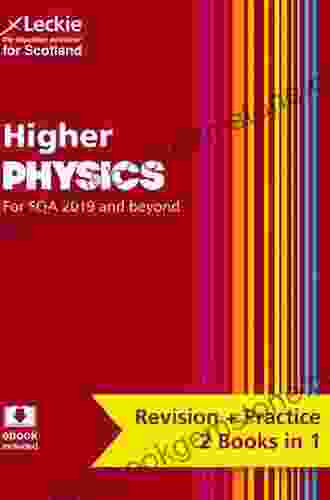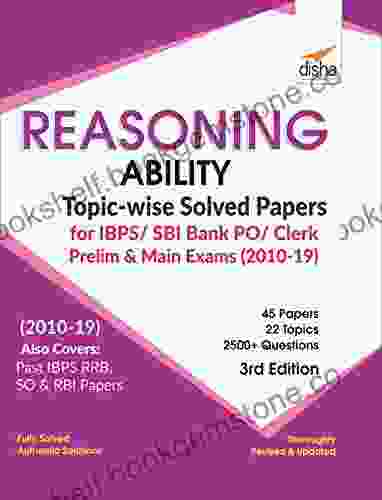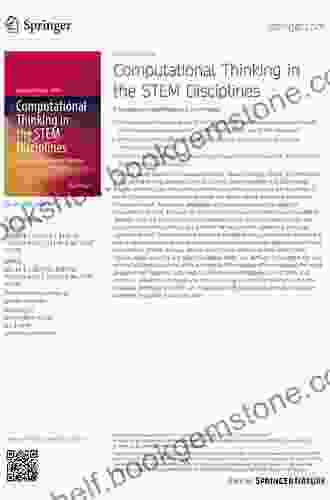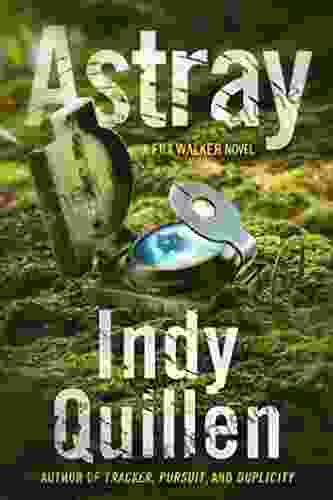Computational Thinking: A Catalyst for Innovation in STEM Disciplines

In the rapidly evolving landscape of science, technology, engineering, and mathematics (STEM),computational thinking has emerged as a pivotal skillset that empowers individuals to navigate the complexities of the modern world. As an essential component of any STEM discipline, computational thinking transcends the realm of computer science, permeating various fields and fostering transformative advancements.
4 out of 5
| Language | : | English |
| File size | : | 36150 KB |
| Text-to-Speech | : | Enabled |
| Screen Reader | : | Supported |
| Enhanced typesetting | : | Enabled |
| Word Wise | : | Enabled |
| Print length | : | 335 pages |
Delving into Computational Thinking: A Multifaceted Paradigm
At its core, computational thinking encompasses a set of mental processes that equip individuals with the ability to solve problems, design systems, and understand human behavior from a computational perspective. This encompasses a range of cognitive abilities, including:
- Problem-Solving: Decomposing complex problems into smaller, manageable chunks and developing algorithmic solutions.
- Logical Reasoning: Employing logical operators and conditional statements to analyze and infer relationships within data.
- Algorithmic Thinking: Constructing step-by-step instructions that can be executed by a computer to solve a problem.
- Data Analysis: Collecting, organizing, and interpreting data to uncover patterns and trends.
Computational Thinking in Practice: Empowering STEM Innovations
The transformative power of computational thinking extends across the entire spectrum of STEM disciplines, manifesting in groundbreaking advancements:
1. Scientific Research: Computational thinking empowers scientists to analyze vast datasets, simulate complex systems, and develop predictive models. This has revolutionized fields such as genomics, bioinformatics, and climate modeling.
2. Engineering Design: Engineers leverage computational thinking to design and optimize complex systems, from aircraft to self-driving cars. Computational simulations and finite element analysis enable them to test and refine designs with unprecedented accuracy.
3. Technological Advancements: Computational thinking is the backbone of artificial intelligence (AI),machine learning, and data analytics technologies. These advancements are shaping industries, automating tasks, and improving our understanding of the world.
Nurturing Computational Thinking in STEM Education
To foster a generation of STEM professionals equipped with computational thinking skills, educators must prioritize its integration into educational curricula. This involves:
- Early Exposure: Introducing computational thinking concepts at an early age through hands-on activities and coding games.
- Curriculum Integration: Incorporating computational thinking into core STEM subjects, such as mathematics, science, and computer science.
- Interdisciplinary Collaboration: Encouraging collaboration between STEM educators to develop innovative lesson plans that foster computational thinking across disciplines.
: Embracing the Computational Revolution
Computational thinking has emerged as the cornerstone of STEM disciplines, driving innovation, scientific discovery, and technological advancements. By developing and nurturing this skillset, we empower future generations to harness the power of computation to solve complex problems, create groundbreaking technologies, and shape a brighter future for our world.
4 out of 5
| Language | : | English |
| File size | : | 36150 KB |
| Text-to-Speech | : | Enabled |
| Screen Reader | : | Supported |
| Enhanced typesetting | : | Enabled |
| Word Wise | : | Enabled |
| Print length | : | 335 pages |
Do you want to contribute by writing guest posts on this blog?
Please contact us and send us a resume of previous articles that you have written.
 Best Book
Best Book Page Flip
Page Flip Bookshelf
Bookshelf Literary loom
Literary loom Chapter
Chapter Bookish
Bookish PageTurner
PageTurner Bibliophile
Bibliophile Story
Story Inkwell
Inkwell Bookworm
Bookworm Labyrinth
Labyrinth Plot Twist
Plot Twist Prose
Prose Paperback
Paperback Storyteller
Storyteller Sanctuary
Sanctuary Fiction
Fiction Reading
Reading Chronicle
Chronicle Read
Read David Morris
David Morris Mitt Romney
Mitt Romney Nat Brown
Nat Brown 1st Edition Kindle Edition
1st Edition Kindle Edition Scott Coplan
Scott Coplan Janine Robinson
Janine Robinson Michael Tefula
Michael Tefula Damion Hunter
Damion Hunter Joeanna Rebello Fernandes
Joeanna Rebello Fernandes Donnie Smith
Donnie Smith Sumoreads
Sumoreads Curving Earth Publishing
Curving Earth Publishing Christie Sausa
Christie Sausa Eli Wilson
Eli Wilson Michael V Uschan
Michael V Uschan Alina Adams
Alina Adams Johnny Quinn
Johnny Quinn Judy Lipson
Judy Lipson Chris Fagan
Chris Fagan Karen O Toole
Karen O Toole Anne Strathie
Anne Strathie Sara Dawn Johnson
Sara Dawn Johnson Cathy Jackson
Cathy Jackson Lisa Kleypas
Lisa Kleypas Disha Experts
Disha Experts Bruce Barcott
Bruce Barcott Kingsley Augustine
Kingsley Augustine Clair Lasater
Clair Lasater Egon Erwin Kisch
Egon Erwin Kisch Frances Mayes
Frances Mayes Jacob Brezinski
Jacob Brezinski Big Daddy Ozone
Big Daddy Ozone Mario Rizzi
Mario Rizzi Mathivanan Palraj
Mathivanan Palraj Christine Wiebe
Christine Wiebe Pamela Bartley
Pamela Bartley T I Lowe
T I Lowe Tia Williams
Tia Williams Stephen J Pyne
Stephen J Pyne Gideon Labiner
Gideon Labiner Thaddeus Hatter
Thaddeus Hatter Naomi Hansen
Naomi Hansen Rets Griffith
Rets Griffith Arthur Miller
Arthur Miller Nirosha Ruwan
Nirosha Ruwan Tim Brown
Tim Brown Gabriel J Connor
Gabriel J Connor Annika Hernroth Rothstein
Annika Hernroth Rothstein Walter Dare
Walter Dare Lynda Jones
Lynda Jones Bob Duff
Bob Duff Ben Egginton
Ben Egginton Nanette Witmer
Nanette Witmer Janet E Wall
Janet E Wall Chris Santella
Chris Santella Yuki Mano
Yuki Mano David Churchman
David Churchman Shannon Dittemore
Shannon Dittemore Barbara A Lynch Johnt
Barbara A Lynch Johnt Eric Simons
Eric Simons Jon A Archambault
Jon A Archambault John Hodgman
John Hodgman Sergio Rassu
Sergio Rassu Pam Coburn
Pam Coburn Marie Herbert
Marie Herbert Peter Barber
Peter Barber David Faulkner
David Faulkner Bruno Grelon
Bruno Grelon R Bruce Richardson
R Bruce Richardson Approach Guides
Approach Guides Vincent Chidindu Asogwa
Vincent Chidindu Asogwa Clifford D Stark
Clifford D Stark Peter Nichols
Peter Nichols William Friar
William Friar William Mckeen
William Mckeen Templeton Peck
Templeton Peck Tony Burton
Tony Burton Osasumwen Asoro
Osasumwen Asoro Joseph A Citro
Joseph A Citro E C Murray
E C Murray William Cowper Prime
William Cowper Prime Dr Hooelz
Dr Hooelz Tao Le
Tao Le Roald Amundsen
Roald Amundsen Kavitha M
Kavitha M Craig M Kershaw
Craig M Kershaw Bonnie Bley
Bonnie Bley James Patterson
James Patterson Richard Sattora
Richard Sattora Greg Wyshynski
Greg Wyshynski Burt L Standish
Burt L Standish Mark Zegarelli
Mark Zegarelli Tommy Xiao Wan
Tommy Xiao Wan Kim Dinan
Kim Dinan Bob Mckenzie
Bob Mckenzie Bryan Ethier
Bryan Ethier Alexandria House
Alexandria House Joseph Mctaggart
Joseph Mctaggart Wayne Stewart
Wayne Stewart Book Worm Publishing
Book Worm Publishing Bruce Rosenfeld
Bruce Rosenfeld Steve Sonntag
Steve Sonntag Noor Ain
Noor Ain Jan Tristan Gaspi
Jan Tristan Gaspi Hokulani K Aikau
Hokulani K Aikau Geraldine Woods
Geraldine Woods Maya Benami
Maya Benami Hans Staden
Hans Staden Debbie S Miller
Debbie S Miller April Vahle Hamel
April Vahle Hamel Sybille Bedford
Sybille Bedford Nishant Jindal
Nishant Jindal Dr John Hockey
Dr John Hockey Marcia Desanctis
Marcia Desanctis Tim Severin
Tim Severin Jeff Kolby
Jeff Kolby Daniel Farcas
Daniel Farcas Laurie Frankel
Laurie Frankel Jon B Barry
Jon B Barry John Gilstrap
John Gilstrap I C Robledo
I C Robledo Jay Greeson
Jay Greeson Jason Zemcik
Jason Zemcik Lauren Lucien
Lauren Lucien Bruce Spydar
Bruce Spydar Bruce Heyman
Bruce Heyman Omni Reads
Omni Reads Pamela And Fred Peters
Pamela And Fred Peters Sadeqa Johnson
Sadeqa Johnson Leslie Thomas
Leslie Thomas Brent J Burrows Ii
Brent J Burrows Ii Kevin Milton
Kevin Milton Jay Griffiths
Jay Griffiths Businessnews Publishing
Businessnews Publishing Nicky Pellegrino
Nicky Pellegrino Erica Abbett
Erica Abbett Christine A Smyczynski
Christine A Smyczynski John Gregory Smith
John Gregory Smith Jude Deveraux
Jude Deveraux Scott Colby
Scott Colby Tracy Owens
Tracy Owens Pierluigi Spagnolo
Pierluigi Spagnolo Mark Greenside
Mark Greenside Hugh Henderson
Hugh Henderson Dk Eyewitness
Dk Eyewitness Lila Z Rose
Lila Z Rose Craig Medico
Craig Medico Gebshu Kukhet
Gebshu Kukhet Jane Bottomley
Jane Bottomley Graham Mackintosh
Graham Mackintosh Wendy C Crone
Wendy C Crone Taras Grescoe
Taras Grescoe Dinesh Kumar Goyal
Dinesh Kumar Goyal Bob Goddard
Bob Goddard Rafael Ocasio
Rafael Ocasio Charles Dickens
Charles Dickens Brandon Royal
Brandon Royal Ruth Everhart
Ruth Everhart Katie Malachuk
Katie Malachuk Corine Gantz
Corine Gantz Bob Smale
Bob Smale Kelli Lawrence
Kelli Lawrence Sharon Asher
Sharon Asher Bob Reiss
Bob Reiss The Total Travel Guide Company
The Total Travel Guide Company Dennis Stemmle
Dennis Stemmle Smart Edition
Smart Edition James Good
James Good Neal Patterson
Neal Patterson Kathleen Kirkland
Kathleen Kirkland Ashley Schmitt
Ashley Schmitt Manfred Theisen
Manfred Theisen Matt Rendell
Matt Rendell My Daily Russian
My Daily Russian Barbara Krumhardt
Barbara Krumhardt David Mcilroy
David Mcilroy Elizabeth Gardner
Elizabeth Gardner Mark Donnelly
Mark Donnelly Andy Fine
Andy Fine Greg Jacobs
Greg Jacobs Darcy Gaechter
Darcy Gaechter Joe Abercrombie
Joe Abercrombie Balazs Csigi
Balazs Csigi Russ Howard
Russ Howard Shawn Inmon
Shawn Inmon Ben Wildavsky
Ben Wildavsky Boye Lafayette De Mente
Boye Lafayette De Mente Tristan Jones
Tristan Jones Vincent Min
Vincent Min Levison Wood
Levison Wood Original Edition Kindle Edition
Original Edition Kindle Edition Blake Banner
Blake Banner Hicham And Mohamed Ibnalkadi
Hicham And Mohamed Ibnalkadi Dojolab Inc
Dojolab Inc Heather E Schwartz
Heather E Schwartz Brett Edward Whalen
Brett Edward Whalen Richard Bronson
Richard Bronson Brien Foerster
Brien Foerster Sunny Lockwood
Sunny Lockwood Shannon Enete
Shannon Enete Gail Fay
Gail Fay Freya Stark
Freya Stark David L Golemon
David L Golemon Paul Noble
Paul Noble Orson Scott Card
Orson Scott Card Kate Maloy
Kate Maloy Paddy Mcqueen
Paddy Mcqueen Simon Winchester
Simon Winchester Test Masters
Test Masters Anna Curran
Anna Curran Maoz Azaryahu
Maoz Azaryahu Karen Hill Anton
Karen Hill Anton Brandon Stanton
Brandon Stanton Quick Reads
Quick Reads Charles A Wells
Charles A Wells Haim Watzman
Haim Watzman Baby Professor
Baby Professor Pati Jinich
Pati Jinich Terry Palechuk
Terry Palechuk Susan Meissner
Susan Meissner Wilfred M Mcclay
Wilfred M Mcclay Gary Robert Muschla
Gary Robert Muschla Steve Sorensen
Steve Sorensen Barbara Allan
Barbara Allan David Newton
David Newton James A Cashin
James A Cashin Arianna Astuni
Arianna Astuni Steve Hely
Steve Hely Michel Roy
Michel Roy American Math Academy
American Math Academy Anne E Brevig
Anne E Brevig Janet Beissinger
Janet Beissinger Paul Watson
Paul Watson Innovative Language Learning
Innovative Language Learning Kim Heinbuch
Kim Heinbuch Carrie Winstanley
Carrie Winstanley Lori Evert
Lori Evert Rosemarie Allen
Rosemarie Allen Darryl Hughes
Darryl Hughes Don L Gates
Don L Gates Sean Dooley
Sean Dooley Mandee Heller Adler
Mandee Heller Adler Nathan Halberstadt
Nathan Halberstadt Cathy A Malchiodi
Cathy A Malchiodi James Teitelbaum
James Teitelbaum Nicholas Gagnier
Nicholas Gagnier Meghan Mccarthy
Meghan Mccarthy Kevin Griffith
Kevin Griffith Katherine Dunham
Katherine Dunham Janet Evans
Janet Evans Jim Harrison
Jim Harrison William Pitts
William Pitts Doug Hall
Doug Hall Asrai Devin
Asrai Devin Penelope Douglas
Penelope Douglas James D Giovannini
James D Giovannini Robert Crais
Robert Crais Julie Tagg
Julie Tagg Tara Kangarlou
Tara Kangarlou Rick Steves
Rick Steves Robin Hobb
Robin Hobb Clay Boutwell
Clay Boutwell Atul Kalhan
Atul Kalhan Bruce Boudreau
Bruce Boudreau Ed Willes
Ed Willes Les Weatheritt
Les Weatheritt Jonathan A Levi
Jonathan A Levi Benjamin Smith
Benjamin Smith Nahee Park
Nahee Park Wolfedale Press
Wolfedale Press Ryan Murdock
Ryan Murdock Luisa Gastambide
Luisa Gastambide Deanne Howell
Deanne Howell Sigurd F Olson
Sigurd F Olson Stephanie Saldana
Stephanie Saldana Trish Nicholson
Trish Nicholson Diane Lindsey Reeves
Diane Lindsey Reeves Zigzag English
Zigzag English Steven Rothfeld
Steven Rothfeld Ari Mennander
Ari Mennander Tina Cho
Tina Cho Lucas Burns
Lucas Burns Jerry A Pattengale
Jerry A Pattengale Jennifer Steil
Jennifer Steil Deborah Miller
Deborah Miller Stephen Graham
Stephen Graham Wendy Francis
Wendy Francis Oliver Bullough
Oliver Bullough Amanda Barnes
Amanda Barnes Caryn Boddie
Caryn Boddie Gregory Maassen
Gregory Maassen Terrance Zepke
Terrance Zepke Brandon Sanderson
Brandon Sanderson Bryan Nelson
Bryan Nelson Dawn Adlam
Dawn Adlam Rodney Paul
Rodney Paul Rebecca Westrup
Rebecca Westrup Sue Tyson Ward
Sue Tyson Ward Rod Nordland
Rod Nordland Barbara Mould Young
Barbara Mould Young Go Books
Go Books Jon C Stott
Jon C Stott Charles H Dyer
Charles H Dyer Martin Sternstein
Martin Sternstein W Michael Kelley
W Michael Kelley Lance Pototschnik
Lance Pototschnik Suzanne Brickman
Suzanne Brickman Susan Davis Becker
Susan Davis Becker Direct Hits
Direct Hits Bruce Berglund
Bruce Berglund Chantel Acevedo
Chantel Acevedo Maha Alkurdi
Maha Alkurdi Vicki Hearne
Vicki Hearne Dan Myers
Dan Myers Karen George
Karen George Indy Quillen
Indy Quillen Josh Tabor
Josh Tabor R M Patterson
R M Patterson Agnieszka Latocha
Agnieszka Latocha Scott Graham
Scott Graham Mike Sonnenberg
Mike Sonnenberg Kay Walten
Kay Walten Pat Guy
Pat Guy Richard Connor
Richard Connor Marie Cirano
Marie Cirano Julia Ann Clayton
Julia Ann Clayton Roderick J Fraser Jr
Roderick J Fraser Jr C F Carter
C F Carter Kyoan
Kyoan Kayla Chalko
Kayla Chalko Eric Seale
Eric Seale Tara Baukus Mello
Tara Baukus Mello Michael R Lindeburg
Michael R Lindeburg Robert Caprio
Robert Caprio Stephen Tarsitano
Stephen Tarsitano Raja Shehadeh
Raja Shehadeh Griselda Sprigg
Griselda Sprigg Paul Cobley
Paul Cobley S K Gupta
S K Gupta Ingo Berensmeyer
Ingo Berensmeyer Marek Sobski
Marek Sobski Daily Language Learning
Daily Language Learning Georgios Papadakis
Georgios Papadakis John Muir
John Muir Gwenda Cornell
Gwenda Cornell Nic Oatridge
Nic Oatridge Rajani Katta
Rajani Katta Lsatmax Lsat Prep
Lsatmax Lsat Prep Funso Aiyejina
Funso Aiyejina Simon Gervais
Simon Gervais Bobby Orr
Bobby Orr Nilakantasrinivasan J Neil
Nilakantasrinivasan J Neil Lonely Planet
Lonely Planet Tanmay Mehta
Tanmay Mehta Texes Exam Secrets Test Prep Team
Texes Exam Secrets Test Prep Team William W Johnstone
William W Johnstone John Morrison
John Morrison Mary Ann Hogan
Mary Ann Hogan Matt Kalman
Matt Kalman Glenn Rivers
Glenn Rivers Peterson S
Peterson S Rebecca Kaye
Rebecca Kaye Tom Palmer
Tom Palmer Russell Clark
Russell Clark Laura Dave
Laura Dave College Hippo
College Hippo Sally Poncet
Sally Poncet Beth Bartolini Salimbeni
Beth Bartolini Salimbeni Paul Oliver
Paul Oliver Korrel Kanoy
Korrel Kanoy Key Notes
Key Notes Thomas Booth
Thomas Booth Jose Antonio Vargas
Jose Antonio Vargas Ken Horlor
Ken Horlor Lisa Pietsch
Lisa Pietsch Brian Reddington
Brian Reddington Nikki Kazimova
Nikki Kazimova Phyllis Folb
Phyllis Folb John Biggam
John Biggam William Least Heat Moon
William Least Heat Moon Sandra Cain
Sandra Cain Anthony J Bennett
Anthony J Bennett Julian Mcdougall
Julian Mcdougall Ged Gillmore
Ged Gillmore Joshua Obanijesu
Joshua Obanijesu Chris Moss
Chris Moss Louise Heal Kawai
Louise Heal Kawai Marcia Langton
Marcia Langton Peter Ballin
Peter Ballin Devaki Lakshmi
Devaki Lakshmi Blether Travel Guides
Blether Travel Guides Frank Ayres
Frank Ayres Stephanie Lewis
Stephanie Lewis Judy Tilton Brunner
Judy Tilton Brunner John R Morgan
John R Morgan Stephen Hui
Stephen Hui Sarah Vowell
Sarah Vowell 4th Edition Kindle Edition
4th Edition Kindle Edition Dr John T Whiting
Dr John T Whiting Pamela K Lamb
Pamela K Lamb Alison Mcghee
Alison Mcghee Ruth Garner
Ruth Garner Beryl Ratzer
Beryl Ratzer Ed Stafford
Ed Stafford Christina Pawlowski
Christina Pawlowski James Grant Peterkin
James Grant Peterkin Nancy Roe Pimm
Nancy Roe Pimm Roberta Raigh Pryor
Roberta Raigh Pryor Schoolhouse Heaven
Schoolhouse Heaven Barry Eisler
Barry Eisler C Michael Hiam
C Michael Hiam Kindle Edition
Kindle Edition Leland Chant
Leland Chant Jack Donnelly
Jack Donnelly Natalya Androsova
Natalya Androsova Jeffrey Brautigam
Jeffrey Brautigam Martin J Pring
Martin J Pring Arden Rembert Brink
Arden Rembert Brink Seymour Resnick
Seymour Resnick Jeanne St James
Jeanne St James Tim Wharnsby
Tim Wharnsby Lizabeth Hardman
Lizabeth Hardman Russell Blake
Russell Blake Er Sunil Batra
Er Sunil Batra Magi Nams
Magi Nams Nicole Chung
Nicole Chung Robert Andrew Powell
Robert Andrew Powell Sacha Black
Sacha Black 8th Edition Kindle Edition
8th Edition Kindle Edition Nicholas Hirshon
Nicholas Hirshon Lawrence W Tuller
Lawrence W Tuller N K Jemisin
N K Jemisin Paul Volponi
Paul Volponi Gregory J Privitera
Gregory J Privitera Daryl Balfour
Daryl Balfour Lee Jamison
Lee Jamison Ginger Sinsabaugh
Ginger Sinsabaugh Elijah N Daniel
Elijah N Daniel Genius Reads
Genius Reads Brad Olsen
Brad Olsen Audiolearn Content Team
Audiolearn Content Team David Baldacci
David Baldacci Chuck Gormley
Chuck Gormley Rick Townsend
Rick Townsend Michael Vlessides
Michael Vlessides Susan Straight
Susan Straight Tiara R Brown
Tiara R Brown Illustrated Edition Kindle Edition
Illustrated Edition Kindle Edition Borja Loma Barrie
Borja Loma Barrie Jess Tiffany
Jess Tiffany Ronald A Reis
Ronald A Reis Tyler Omoth
Tyler Omoth Sylvain Tesson
Sylvain Tesson Tracy Brown Collins
Tracy Brown Collins Robert Louis Stevenson
Robert Louis Stevenson Barbara Fradkin
Barbara Fradkin Elke Gschossmann Hendershot
Elke Gschossmann Hendershot Gerry Lekas
Gerry Lekas Robert A Johnson
Robert A Johnson James Rollins
James Rollins Rashaun Johnson
Rashaun Johnson Dan Fullerton
Dan Fullerton Ryszard Kapuscinski
Ryszard Kapuscinski Lori Haskins Houran
Lori Haskins Houran Jason Hogan
Jason Hogan Peter Liljedahl
Peter Liljedahl Mary Jo Mcconahay
Mary Jo Mcconahay Nick Adams
Nick Adams Nick Kypreos
Nick Kypreos Cristen Hemingway Jaynes
Cristen Hemingway Jaynes Suzanne Reece
Suzanne Reece Bobby Newman
Bobby Newman Peter Mcdougall
Peter Mcdougall Johan Reinhard
Johan Reinhard James A Michener
James A Michener Doretta Groenendyk
Doretta Groenendyk Devin Carroll
Devin Carroll Brian Clegg
Brian Clegg Jason E Portnof
Jason E Portnof Marty Gitlin
Marty Gitlin Marty Ofonagoro
Marty Ofonagoro Alex Kava
Alex Kava Sam Quek
Sam Quek Jose M Forero Bautista
Jose M Forero Bautista Pico Iyer
Pico Iyer Michael Egan
Michael Egan Gill James
Gill James Brian Leaf
Brian Leaf Reinaldo Arenas
Reinaldo Arenas Print Replica Kindle Edition
Print Replica Kindle Edition Steven Schneider
Steven Schneider Eunice Lewis Ph D
Eunice Lewis Ph D Brian Andrews
Brian Andrews John Hersey
John Hersey C Rich
C Rich Thant Myint U
Thant Myint U Miles Martin
Miles Martin Daniel Mode
Daniel Mode Maria Elena Alonso Sierra
Maria Elena Alonso Sierra Anton Chekhov
Anton Chekhov Lori Schumacher
Lori Schumacher Joanna Kujawa
Joanna Kujawa Lois Pryce
Lois Pryce Study Guide Edition Kindle Edition
Study Guide Edition Kindle Edition J A Johnstone
J A Johnstone Kristin Hannah
Kristin Hannah C F Crist
C F Crist Simon Bird
Simon Bird Thad Vogler
Thad Vogler Shannon Ables
Shannon Ables Wilfred Cude
Wilfred Cude Linda Anne Silvestri
Linda Anne Silvestri Leckie
Leckie Lisa Mcclendon Sims
Lisa Mcclendon Sims Barry Broadfoot
Barry Broadfoot Stephen Haddelsey
Stephen Haddelsey Beau Riffenburgh
Beau Riffenburgh Robert Whiting
Robert Whiting Bill Ingersoll
Bill Ingersoll John Mcphee
John Mcphee Bill Streever
Bill Streever Ted Dorsey
Ted Dorsey Ben Cook
Ben Cook Nelson Demille
Nelson Demille Paul Deepan
Paul Deepan Annabel Chase
Annabel Chase Brian Kent
Brian Kent Jamie Pedrazzoli
Jamie Pedrazzoli Cyprian Mendonca
Cyprian Mendonca Viki Winterton
Viki Winterton Dmv Test Bank
Dmv Test Bank Julie Argyle
Julie Argyle Susan Jane Gilman
Susan Jane Gilman Anselme Baud
Anselme Baud Janisse Ray
Janisse Ray Kenneth Cline
Kenneth Cline Brad Dude
Brad Dude Printright
Printright Brad Anderson
Brad Anderson Daniel Putkowski
Daniel Putkowski John Otis
John Otis Jackson Carter
Jackson Carter Shirley J Shepherd
Shirley J Shepherd Barzin Pakandam
Barzin Pakandam Ben Buckton
Ben Buckton Alice Morse Earle
Alice Morse Earle George J Hademenos
George J Hademenos H M Conroy
H M Conroy Emma Sue Prince
Emma Sue Prince Joseph Toone
Joseph Toone Sarah Smierciak
Sarah Smierciak Jeri Magg
Jeri Magg Michael Lieberman
Michael Lieberman Paul Blanchard
Paul Blanchard Pass Your Class
Pass Your Class Angelo Tropea
Angelo Tropea Intelligent
Intelligent R K Agarwal
R K Agarwal William Beebe
William Beebe Nick Jans
Nick Jans Culture Smart
Culture Smart Bret Baier
Bret Baier Vernon G Zunker
Vernon G Zunker Blair Braverman
Blair Braverman Erfun Geula
Erfun Geula Gerald Durrell
Gerald Durrell Gray Malin
Gray Malin
Light bulbAdvertise smarter! Our strategic ad space ensures maximum exposure. Reserve your spot today!

 Abe MitchellUnveiling the Elite Abilities and Inspiring Journey of Hockey Goaltender Eli...
Abe MitchellUnveiling the Elite Abilities and Inspiring Journey of Hockey Goaltender Eli...
 Frank MitchellGuatemala Cruisers Guide to Rio Dulce: A Comprehensive Guide to the Most...
Frank MitchellGuatemala Cruisers Guide to Rio Dulce: A Comprehensive Guide to the Most... Gabriel Garcia MarquezFollow ·6.2k
Gabriel Garcia MarquezFollow ·6.2k Davion PowellFollow ·6.4k
Davion PowellFollow ·6.4k Louis HayesFollow ·10k
Louis HayesFollow ·10k Paulo CoelhoFollow ·5.2k
Paulo CoelhoFollow ·5.2k Adam HayesFollow ·15.5k
Adam HayesFollow ·15.5k Francis TurnerFollow ·16k
Francis TurnerFollow ·16k Alvin BellFollow ·19.6k
Alvin BellFollow ·19.6k Jermaine PowellFollow ·14.9k
Jermaine PowellFollow ·14.9k

 Douglas Powell
Douglas PowellPreparation and Support for Teacher Assessment: Leckie...
Teacher assessment is an important part of...

 Derek Bell
Derek BellMaster the Basics of Japanese Grammar: A Comprehensive...
Embarking on your journey to master the...

 Edison Mitchell
Edison MitchellReasoning Ability Topic Wise Solved Papers For IBPS SBI...
The Reasoning...

 F. Scott Fitzgerald
F. Scott FitzgeraldA New Survey of the West Indies, 1648: Broadway...
Published in...

 Cooper Bell
Cooper BellPeekaboo Baby Toddler: 150 Animal Flash Cards for...
Are you ready to embark on...
4 out of 5
| Language | : | English |
| File size | : | 36150 KB |
| Text-to-Speech | : | Enabled |
| Screen Reader | : | Supported |
| Enhanced typesetting | : | Enabled |
| Word Wise | : | Enabled |
| Print length | : | 335 pages |










